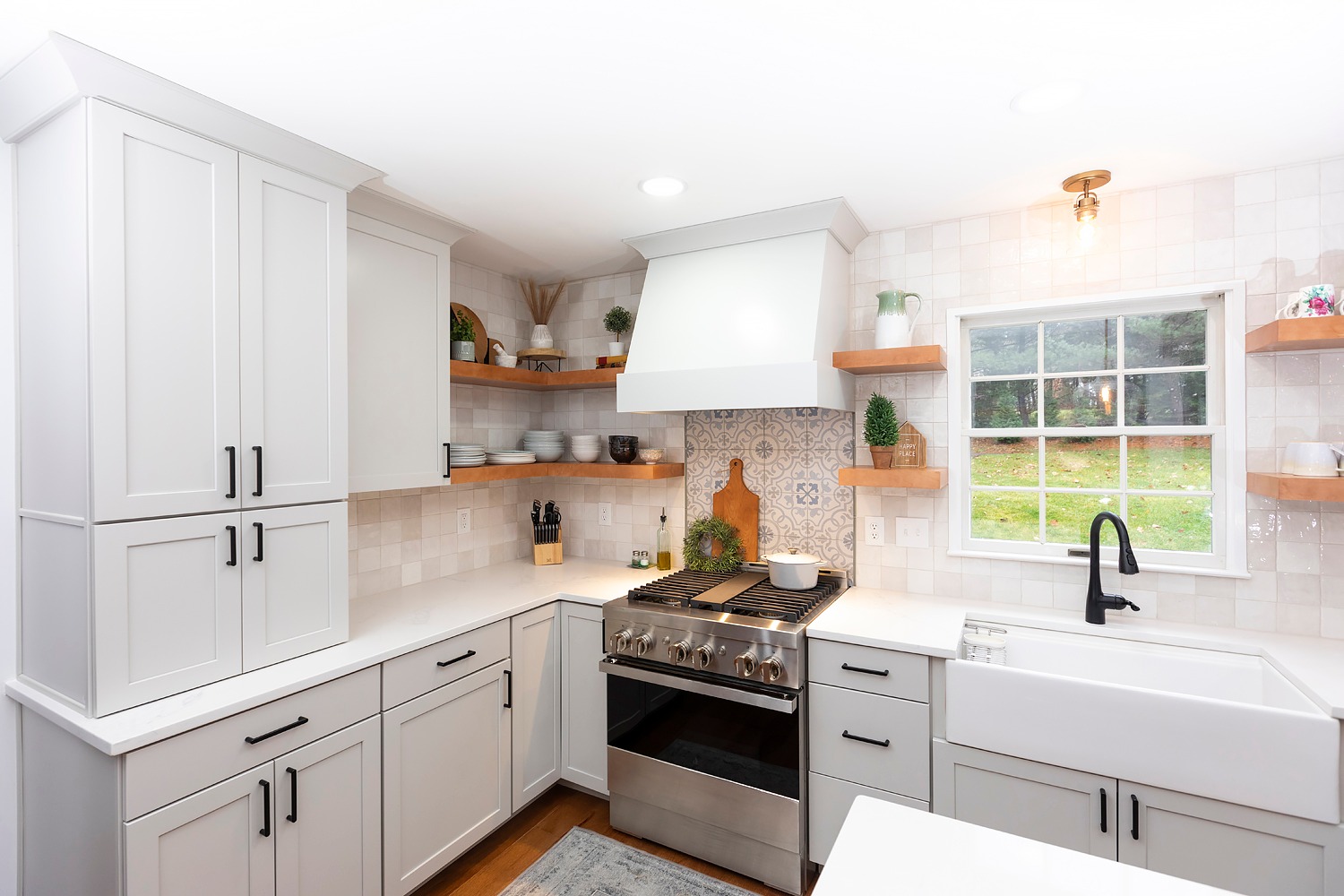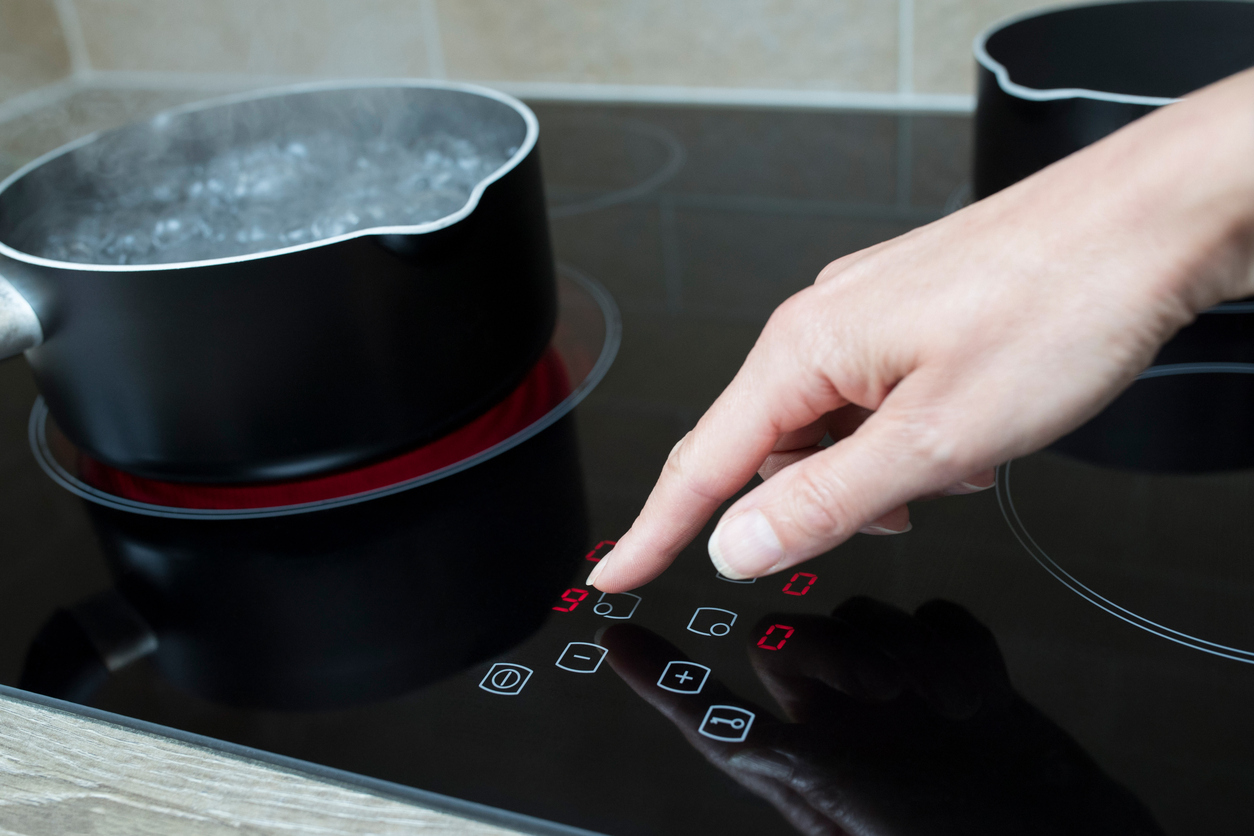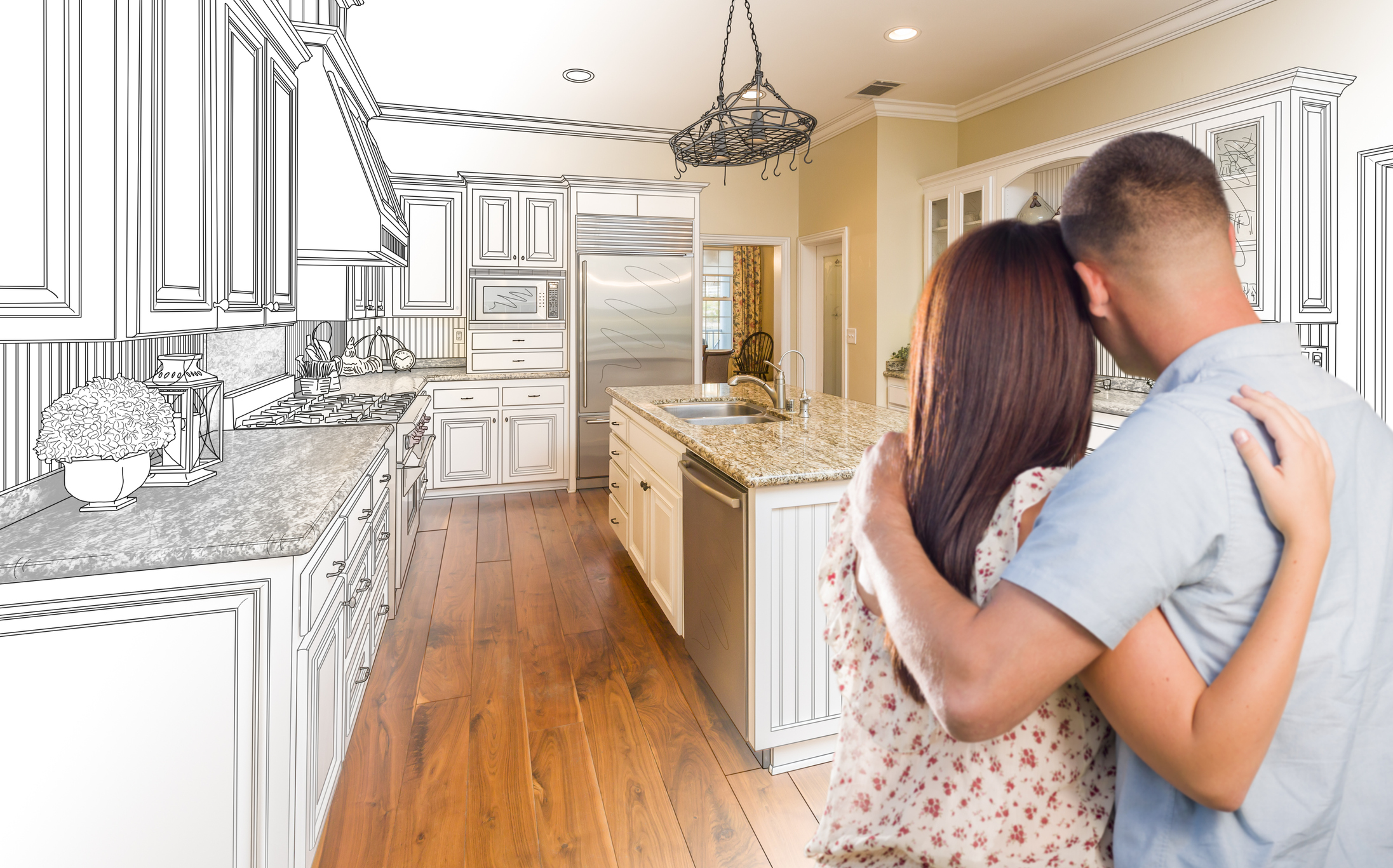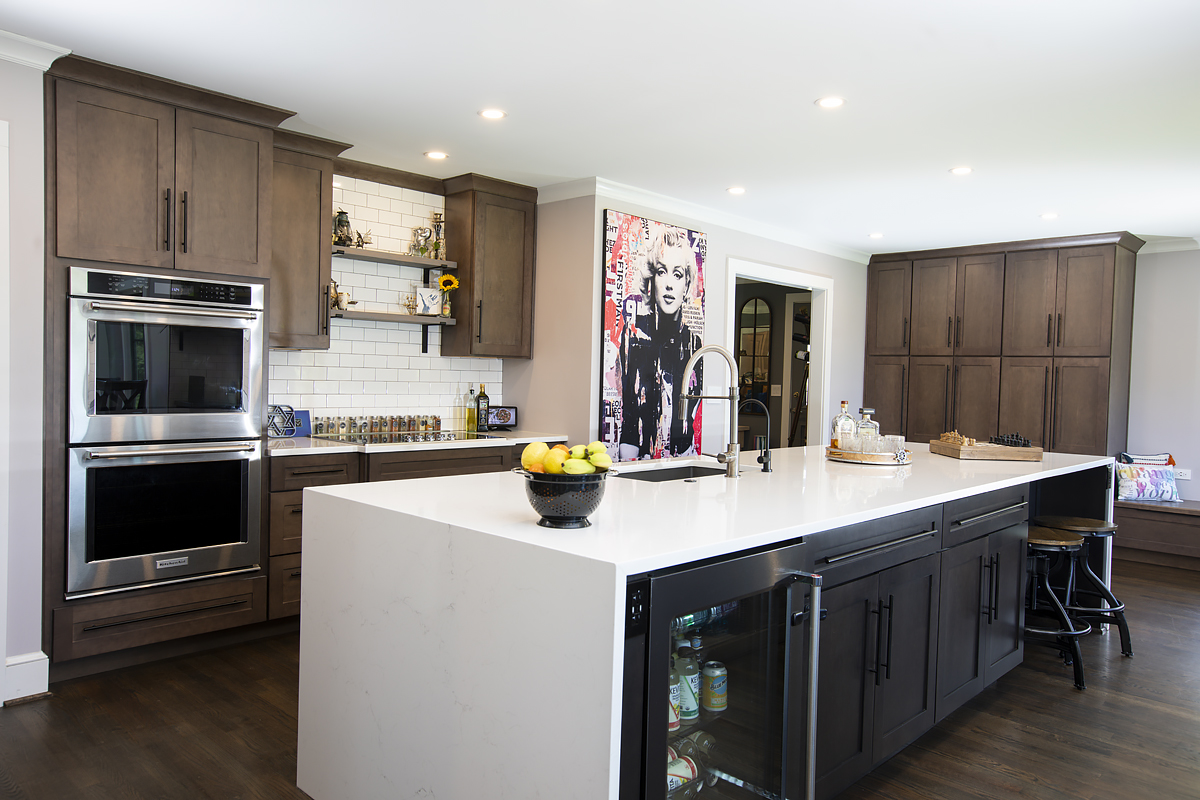Countertops are a big part of any kitchen project. Learn about the many materials they are made from, and the advantages that each one brings with it.

Some of the biggest decisions in any kitchen project concern its countertops. Practically, we interact with the counters perhaps even more than with the cabinets – and that interaction can be quite harsh with all the cutting and pounding and high temperatures that food preparation requires. Visually, they take up a lot of eye-space. If not chosen well, an otherwise beautiful kitchen can be aesthetically ruined. Likewise, sometimes a change of countertop is all that is needed to give the whole kitchen a fresh new look.
Obviously, some questions will have highly subjective answers, like which color or pattern or which edge profile should be used. We recommend consulting with an experienced kitchen designer, who can educate you on what is available and help you visualize the possibilities. This post gives a broad overview of the available surface materials and provides guidance to help you determine the best fit for your project.
First questions
There are many factors to consider: cost, durability, maintenance, and resale value to name a few. You will make your decision based upon how you prioritize those factors. Throughout the process, it is important to keep in mind your ultimate objective:
- Is your kitchen project for your primary home, in which you plan to live for a long time? If so, you will prioritize something that is more durable and aesthetically pleasing. After all, you will want to enjoy using your kitchen countertops for as many years as you can\
- Is your kitchen for a rental home?
- For long-term leases, you will want to pick a material that will last for three to eight years. Fresh kitchens prove to be a top attraction amongst tenants and will retain the longest rental value. . In that case, you may want to use cheaper materials with very easy maintenance, since they may need to be replaced relatively soon.
- For short-term/vacation rentals Is your kitchen for a short-term rental / vacation home? You will definitely want to think about material durability and ease of maintenance, since you will be needing to return your kitchen to an as-close-to-new-as-possible condition frequently, perhaps every few days.
Remember, the condition of the kitchen is a major selling-point for vacationers.
- Are you redoing your kitchen because you are selling your home? This is a bit more tricky. Conventional wisdom says that a remodeled kitchen adds value to your home. However, most homebuyers undertake some form of remodeling within the first year of purchase, and many of those choose to do their kitchen first. In that case, a buyer may be less likely to purchase a home that has already received expensive kitchen upgrades. Ultimately, you will want to consult with your real estate agent about what materials would give you “the most bang for the buck” in your specific market.
Material comparisons

There are many, many types of countertop surface materials, and each one will have its own characteristics. To keep things simple, we will put them together into the following, broad categories:
- Laminate: Laminate countertops are made of essentially two parts. The bottom, creating the form of the countertop, is particle board or fiberboard (MDF). Bonded to the bottom is a thin layer of laminate, consisting of the decorative, printed paper layer. The top is coated in a plastic, protective layer.
- Construction materials: While most countertops are made from preformed slabs of material, these types of tops are created specifically for the project at hand. Concrete (or cement) and tile are a couple of examples of materials that are often used in this application. To make these tops, forms are built to fit the precise measurements of the existing kitchen, including any cutout areas for sinks or stove tops, and then the material is either poured (e.g. concrete) or laid (e.g. tile) accordingly. The fabrication of these tops may happen remotely, but they may also be constructed immediately in place
- Wood: Countertops made from woody materials (including bamboo, which is technically in the grass family and not a tree) are considered by many to be the most eco-friendly option. The source materials are all natural, and fully renewable. They are usually manufactured by taking either planks or strips and layering them together with non-toxic adhesives, which are then pressed together until fully bonded. The resulting board is then planed and sanded to a smooth finish, and prepared for installation.
- Engineered Solid Surface: These countertops are manufactured from material that is made using combinations of minerals and polymers like acrylic. Aesthetic details like color, veining, or other additives (e.g. stone chips or glass fragments) will permeate the entire mixture. The mix is poured into casts and allowed to harden under the proper temperature and pressure. Often the result is a standard-sized slab of material that is later fabricated into the specific countertop, although it is also possible to custom-make the cast for the specific application.
- Engineered stone: Engineered stone countertops, often generically called “quartz countertops,” are manufactured in a similar way as their solid surface counterparts. The main difference is the ingredient list. Engineered stone uses real, quarried stones which are crushed and mixed together with bonding agents before being compressed together in a hot kiln. After they cool down again, the slabs of material are polished and prepared for installation.
- Natural stone: When the topic of natural stone countertops is raised, most people automatically think of granite or marble. However, there are many other types of stone that can be used, like limestone, slate, basalt, soapstone, etc. Natural stone countertops begin their journey as slabs of rock taken from quarries around the world. They are then cut to size and polished to a smooth finish.
| Material | Cost | Style Options | Installation | Maintenance | Durability | Home Impact |
| Laminate | Low | 100,000s | Easy | Low | Moderate; 20-30 years | Low |
| Construction Material | Low to Medium | Trendy; Lots of combinations | Moderate | Medium to High | Medium to High; 50 – 100 years | Mixed; Can be high for trendy areas |
| Wood | Medium to High | Limited | Easy | High | High; 100+ years | Mixed; Can be high depending on demographics |
| Engineered Surfaces | Medium | 100,000s | Moderate | Low | Medium; 10+ years | Medium to high |
| Engineered Stone | Medium | 100s | Complex | Low | High; 100+ years | High |
| Natural Stone | High | 100s | Complex | High | High; 100+ years | High |
- Cost: Low
Laminate countertops are among the cheapest materials available. The cost is usually driven by the color or pattern style, though other factors like the finish or edge options impact pricing. Many manufacturers put their colors and patterns together in price groups, which makes it a fairly convenient and straight-forward way to estimate material costs.
- Appearance:
Almost limitless colors and patterns are available, making them useful in many style settings. Some laminates even incorporate texture through 3D printing, recreating both the look and the feel of other materials (e.g. stone) while maintaining their cost advantage. There are also different options available for edges and corners.
- Installation: Easy
These lightweight counters are DIY friendly, and can be easily cut or modified in place, using common tools and hardware. Once installed, they can be used almost immediately.
- Maintenance: Low
Laminate tops do not require extra care or the application of protective sealants. They can be easily cleaned with warm water and mild dish soap.
- Durability: Moderate
Depending on the quality, there will be low to moderate resistance to scratching and staining. Some laminates may be damaged by hot pots or pans if placed directly on it. The laminate’s color and finish may fade a minimal amount if exposed to direct sunlight. Laminate can also become crushed or chipped and, depending on the location of the damage, may not easily be restored.
- Average life expectancy: 20-30 years
- Home value impact: Low
Even though quality improvements have given laminate countertops a better reputation, they are still considered a low-end option and are not advisable if the objective is to increase home value.
Construction material: Concrete & Tile
- Cost: Medium (concrete); Low (tile)
The cost of these tops is linked to the materials involved and any modifications to those materials that are required (e.g., adding color to otherwise plain concrete). Because these countertops are custom built for each project, they take time and expertise to build and increases the cost.
- Appearance:
(Concrete) Though typically used in more rustic applications, these tops are attractive and are increasingly used in more trendy environments. Pigments for color, or other materials (e.g. glass fragments) can be included into the mix to give it a life of its own.
(Tile) There are near-endless possibilities of available colors, patterns and styles of tile. Different styles can also be put together into a single countertop. The color of grout can be chosen to either blend with the tile or to contrast with it, each with its own effect.

- Installation: Moderate
Though they can be DIY, if you don’t have sufficient experience with forming concrete or laying tile it is best to hire a professional. They take a long time to fully cure (up to about 1 month) and cannot be used immediately.
- Maintenance: Medium to high
Materials like concrete are very porous and must be sealed and waxed regularly. Even when waxed, they can still be easily stained and must be cleaned immediately and carefully, avoiding any abrasive cleaners which can damage the sealant.
While tile itself is relatively hassle free, the grout used between them needs to be protected, especially against mold or bacteria.
- Durability: Medium to high
Concrete counters are very resistant to cuts and scratches and can withstand direct heat. They do tend to form small cracks due to moisture content, temperature differentials, and the house settling. Most damage that occurs, however, can easily be repaired.
Tile is very resistant to scratching and temperature changes (hot pans can be placed directly on them), although some tiles are prone to chipping. These defects are easily repaired, however, provided that replacement tiles have been kept for that purpose. Even if regularly maintained, the grout may become worn, and may need to be replaced.
- Average life expectancy: 50 years (concrete); 100+ years (tile)
- Home value impact: High (concrete); Mixed (tile)
Especially if made and maintained well, the unique / niche nature of concrete countertops can give your home a special edge to potential buyers who may otherwise only see factory-made counters in other homes. Tile countertops were in vogue especially in the 70’s and 80’s, and give dated look to the home. It would not be recommended to install them for the purpose of resale. However, they are a returning trend in certain sectors and, depending on their style and the quality of workmanship, they may have an overall positive effect on home value.
- Cost: Medium to high
The cost of wooden tops largely depends on the specific type of wood that is used, and their grain orientation (see below) which affects the manufacturing process.
- Appearance:
Wooden tops often contribute to a very pleasing ambience in a kitchen, not just because of their appearance but also because they are a softer material that has sound-absorption properties. Depending on your preferences, there are two different ways the grains can be oriented: vertically (called “end-grain”), or horizontally (called either “edge-grain” or “face-grain,” depending on how the boards are laid). End-grain boards are generally hardier but are often considered less aesthetically pleasing and will be more limited on the edge-profile. Edge-grain or face-grain boards are often preferred aesthetically and can be profiled more easily, but they are also more susceptible to damage.
- Installation: Easy
Wooden countertops are DIY friendly. They are heavier than laminate tops, and so will be more difficult to put into place and adjust, but they only require common tools and hardware. Because they are natural materials, they will expand and contract with temperature and moisture. It is important to let them acclimate in the home environment for a few days before installing, and to give them some breathing room to prevent expansion damage later. Once installed, they can be used immediately.
- Maintenance: High
Wooden tops must be oiled and sealed regularly to prevent them from drying out. They are very susceptible to staining. Spills should be cleaned immediately using cleaners that are safe for wood.
- Durability: Medium to high
Different wood types are more resistant to scratching and denting than others. The grain orientation also affects their hardiness. They are not heat resistant and, if not properly cared for, the may begin to warp. However, if they well cared for, they are not likely to chip or crack, and any damage they do sustain can usually be repaired and refinished to near-new condition.
- Average life expectancy: 100+ years
- Home value impact: Mixed
The aesthetic qualities and durability of wooden countertops can increase a home’s value, provided that they have been well maintained and fit current design trends. However, they also generally appeal to a particular type of person, which may lower the interested-buyer base and affect the home’s marketability.
- Cost: Medium
The cost of factory-standard solid surface countertops will be largely dependent on the color or pattern that is chosen. Custom tops will be more expensive.

- Appearance:
Solid surface countertops have near-endless possibilities of colors and patterns. Edges can be profiled in many different ways. The material’s smooth surface lends itself to presenting a very clean environment and provides a more upscale, trendy aesthetic.
- Installation: Moderate
Generally, fabricating and installing a solid surface countertop requires a high level of expertise and special tools and is not very DIY friendly. Fabrication generally takes place off-site. Sections of the countertop can be transported individually and then glued together on-site to form seamless, single top. If gluing is necessary, it is advisable to wait for a short while before using the tops; otherwise, they can be used immediately after installation.
- Maintenance: Low
Engineered solid surface countertops are not porous and do not need regular sealing or protective wax. They easily wipe clean with warm water or, if necessary, some mild soap.
- Durability: Medium to high
The material used in engineered solid surface countertops is relatively soft, especially when compared to engineered stone or natural stone. It can be scratched easily and is not heat resistant. The material is unlikely to form cracks unless poorly installed. If the top does become damaged, it can usually be repaired or restored. It maintains its color and is not known for fading.
- Average life expectancy: 10+ years.
- Home value impact: Medium to high
Since engineered solid surface countertops are often compared to and cited as an alternative to natural stone, they can provide a modest return-on-investment (more than laminate tops and less than natural stone). However, their lower life expectancy could be a detraction to some buyers, who may anticipate the need to replace them relatively soon.
- Cost: Medium
Engineered stone countertops are seen as a viable alternative to natural stone; possessing most of the important qualities of stone but manufactured on an assembly line, which dramatically reduces their cost. As with most other materials, the cost of engineered stone will be determined largely by chosen color / pattern and finish.
- Appearance:
Some engineered stone counters can closely approximate the looks of natural stone, and it may be hard for the untrained eye to tell the difference. Their manufacturing process allows for a lot of versatility in color, veining, and other additives for enhanced visual appeal. Edges can be profiled with a router.
- Installation: Moderate to complex
Engineered stone is quite labor-intensive to fabricate and install and requires specialized equipment to do so. They are heavy and may be difficult to transport and put into position. Like anything, they are DIY possible, but they generally require some expertise. They can generally be used right away after installation.
- Maintenance: Low
Engineered stone, unlike natural stone, is not porous, so it does not need any sealants. Cleaning requires only a soft cloth in warm water and mild soap.
- Durability: High
Engineered stone is very resistant to scratching and staining. It can normally withstand high temperatures, although the resins used in some lower quality products may react to sudden temperature changes. While they may be susceptible to chipping on the edges, especially if not fabricated or installed well, it is possible for expert stone workers to repair them.
- Average life expectancy: 100+ years
- Home value impact: High
Because engineered stone countertops carry most of the aesthetic and durability positives of natural stone but are less intensive with care and maintenance, they are a strong contributor to home values. Prospective buyers are attracted to them for their quality and style.
- Cost: High
Natural stone countertops are among the most expensive options, although there are some less expensive options. This is driven both by the material itself and by the labor-intensive fabrication process.
- Appearance:
The many types of stones that can be used translates into many different colors and veining patterns. Most importantly, natural stone is inherently attractive, and each stone countertop is one-of-a-kind.
- Installation: Complex
Natural stone countertops are not DIY friendly. The fabrication process of natural stone countertops is labor-intensive, and requires specialized tools and equipment. The tops are also very heavy, and can be difficult to put into place and affix. Once installed, it is advised to wait about 24 hours before using them, to ensure good adhesion and also to allow the sealants to cure.
- Maintenance: High
The maintenance requirements of natural stone countertops depends somewhat on the stone that is used. Most stones are naturally porous, and must be sealed or waxed regularly. When cleaning, anything acidic or abrasive should be avoided to prevent etching or damage to the sealant layer.
- Durability: High
While stones vary in their hardness, most natural stone countertops are very resistant to scratching and chipping, and they hold their color well. Hot pots and pans can usually be placed right onto them without effect. If the tops do become damaged, it may be possible to repair them, depending on the location and nature of the damage.
- Average lifespan: 100+ years
- Home value impact: High
Natural stone is a premium material. It presents an air of quality and luxury. It also does not depreciate in its own value, regardless of current style and design trends. They are attractive to potential buyers, and give the home a marketing edge. Overall, natural stone offers an excellent return on investment.
Other materials
The above categories only cover the most common countertop materials that a typical homeowner would be in the market for. Industrial settings would likely prefer stainless steel counters, not so much for their looks but for their durability, ease of maintenance, superior resistance to heat and even fire, and of course their hygienic properties. Some niche consumers may have countertops made for them from many different types of materials, including glass, porcelain, or recycled aluminum. A newer engineered material consisting primarily of quartz, glass and porcelain, called “Dekton,” was introduced about a decade ago. It is hailed as perhaps the most durable and easily maintained material that is available, but it also comes with a hefty price tag that surpasses even natural stone.
Choosing the right countertop for you
The information that we presented above is – pardon the pun – merely scratching the surface. If you are in the market for new countertops, we encourage you to consult with our design professionals at Carefree Kitchens. They have many years of collective experience, working in many different types of communities and home environments, and can guide you with more detailed and personalized information for your specific project. Some countertop materials can be fabricated right in our own workshop, though we have the connections necessary to outsource others. Contact us today: we’re here to help.
Counting the cost
No matter what your project objectives may be, it is unavoidable – especially in our current economy – that the bottom line will play a significant role in your decisions.
Most countertop materials are sold in the United States with a price per square foot. That price can be easily calculated just by taking necessary measurements. However, the full cost will also involve fabrication and installation. By “fabrication,” we mean any preparation work (cutting to size, joining at angles, making cutouts for sinks, etc) that is necessary to make the countertop fit the project. The nature of the industry is that the cost of fabrication rises and falls with the cost of the materials, if for no other reason than pricier materials generally require a higher level of expertise. Once fabricated, the countertops must be put into place, which may also be an expensive prospect depending on the location, accessibility, and overall condition of the installation area.
All of these factors should be kept in mind when shopping for your new countertops, as they may make the difference in your decision.









+ Show / Hide Comments
Share to: